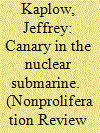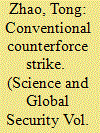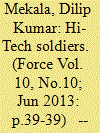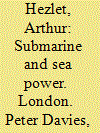| Srl | Item |
| 1 |
ID:
160990


|
|
|
|
|
| Summary/Abstract |
With the continued use of unsafeguarded naval nuclear-propulsion programs in all nuclear-weapon states, the commissioning of an Indian nuclear submarine, and the potential investment in such programs by non-nuclear-weapon states including Brazil and South Korea, movement toward a regulatory regime for nuclear material in the naval sector has become imperative. Such a framework faces a recurring debate on adequately protecting sensitive military technology while delivering assurances that naval nuclear material is not diverted to nuclear-weapon programs. In this viewpoint, we examine various prospective mechanisms to regulate naval nuclear stocks and assess them in terms of their effectiveness and scope. Drawing on lessons from the drafting, negotiation, and implementation of the Model Additional Protocol, we recommend a safeguards regime for naval nuclear material via a protocol that supplements the existing global nuclear-governance system. This protocol provides a standardized yet flexible approach to naval nuclear-material safeguards across all states (whether nuclear-weapon states, non-nuclear-weapon states, or outside the Treaty on the Non-Proliferation of Nuclear Weapons) to handle variations among naval nuclear fuel cycles and technologies.
|
|
|
|
|
|
|
|
|
|
|
|
|
|
|
|
| 2 |
ID:
143304


|
|
|
|
|
| Summary/Abstract |
The Treaty on the Non-Proliferation of Nuclear Weapons (NPT) allows states to exempt nuclear material from international safeguards for use in nuclear submarine programs. This material, however, could be diverted for nuclear weapons purposes without the knowledge of inspectors, creating a potentially dangerous loophole in the treaty. This article argues that exercising that loophole today would amount to admitting a nuclear weapon program, making it a particularly poor pathway to a weapon for a potential proliferant. Still, if states like Brazil ultimately exempt nuclear material from safeguards for a nuclear submarine effort, they could set a dangerous precedent that makes it easier for others to use the loophole as a route to a nuclear weapon capability. There are several policy options available to mitigate the damage of such a precedent; most promising is the prospect of a voluntary safeguards arrangement that would allow international inspectors to keep an eye on nuclear material even after it has been dedicated to a naval nuclear propulsion program.
|
|
|
|
|
|
|
|
|
|
|
|
|
|
|
|
| 3 |
ID:
108152


|
|
|
|
|
| Publication |
2011.
|
| Summary/Abstract |
China and some other nuclear-armed countries have become concerned about the development and deployment of U.S. conventional global strike systems that may permit damage limitation operations against the nuclear forces of adversaries. This article argues that a counterforce strike is more likely to target tactical nuclear forces than intercontinental ballistic missiles and provides an analysis of the probability that U.S. conventional strikes might destroy China's theater nuclear forces which include DF-3A, DF-4, DF-21, DF-31 missiles, Type 094 nuclear submarines, and nuclear-capable H-6 bombers. The results indicate that China's strategy of building robust underground facilities may effectively protect its nuclear forces from preemptive strikes making it unlikely that a U.S. conventional strike could destroy a meaningful part of China's theater nuclear forces. This study also assesses the potential capabilities of future conventional prompt global strike systems, points out problems with the strategy of damage limitation, and proposes that the United States consider improving strategic stability in its relationship with China rather than threatening a preemptive strike.
|
|
|
|
|
|
|
|
|
|
|
|
|
|
|
|
| 4 |
ID:
043047


|
|
|
|
|
| Publication |
London, Arthur Barker, 1967.
|
| Description |
382p.
|
|
|
|
|
|
|
|
|
|
|
|
Copies: C:1/I:0,R:0,Q:0
Circulation
| Accession# | Call# | Current Location | Status | Policy | Location |
| 000730 | 359.9383/STA 000730 | Main | On Shelf | General | |
|
|
|
|
| 5 |
ID:
122619


|
|
|
| 6 |
ID:
043049


|
|
|
|
|
| Publication |
London, Peter Davies, 1967.
|
| Description |
ix, 278p.
|
|
|
|
|
|
|
|
|
|
|
|
Copies: C:1/I:0,R:0,Q:0
Circulation
| Accession# | Call# | Current Location | Status | Policy | Location |
| 002070 | 359.9383/HEZ 002070 | Main | On Shelf | General | |
|
|
|
|